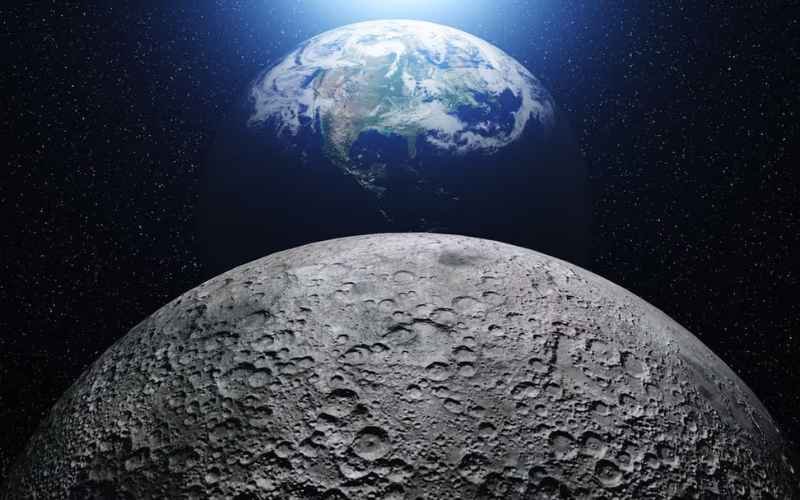In a universe constantly in motion, the celestial dance between the Earth and its moon has long fascinated scientists and stargazers alike. Recent studies reveal a subtle but significant shift: the moon is slowly drifting away from Earth. This gradual change could have profound implications for our planet, potentially leading to longer days in the distant future. Could we really see 25 hours in a day? Let’s explore this intriguing possibility.

The Lunar Drift: A Slow but Steady Departure
The moon is slowly drifting away from Earth at an average rate of about 3.8 centimeters (1.5 inches) per year. This phenomenon, known as lunar recession, is primarily caused by the complex tidal interactions between the Earth and the moon.
The Mechanics of Lunar Recession
- Tidal Forces:
- The moon’s gravitational pull affects Earth’s oceans, creating tidal bulges. These bulges are the high tides we observe on the sides of the Earth facing towards and away from the moon.
- Earth’s Rotation:
- As Earth rotates, it drags these tidal bulges along its surface. Due to Earth’s faster rotation relative to the moon’s orbit, the bulges are slightly ahead of the moon’s position in the sky.
- Gravitational Interaction:
- The gravitational interaction between the moon and these tidal bulges results in a transfer of energy. The bulges exert a forward pull on the moon, while the moon exerts a backward pull on the Earth’s rotation. This exchange of forces causes a gradual but continuous change in both the Earth’s rotation and the moon’s orbit.
The Consequences of Lunar Recession
- Lengthening Days:
- As the moon moves away, the Earth’s rotation slows down. This results in the gradual lengthening of our days. It is estimated that hundreds of millions of years ago, a day on Earth was much shorter than the current 24-hour period.
- Changes in Tides:
- The receding moon also affects tidal patterns. Over millions of years, as the distance increases, the gravitational influence of the moon on Earth’s tides will decrease, leading to less dramatic tidal effects.
- Long-Term Evolution:
- If this process were to continue indefinitely, the Earth and moon would eventually reach a state called tidal locking, where the Earth’s rotation period matches the moon’s orbital period. This is similar to how the moon is already tidally locked with Earth, always showing the same face to us.
Historical Context and Measurement
- Astronomical Observations:
- The rate of lunar recession has been confirmed through various methods, including precise measurements using lunar laser ranging experiments. These involve bouncing laser beams off retroreflectors left on the moon’s surface by the Apollo missions, providing highly accurate data on the moon’s distance.
- Geological Evidence:
- Geological records, such as the study of ancient tidal rhythmites (sedimentary layers formed by tidal activity), also support the theory of lunar recession. These records provide evidence of changes in Earth’s rotation and the moon’s orbit over geological timescales.
Tidal Forces and Energy Transfer
The gravitational interplay between the Earth and the moon is a fascinating dance of forces and energy. This dynamic relationship involves a continuous and complex exchange of energy, primarily driven by tidal forces.
Tidal Friction and Earth’s Rotation
- Tidal Bulges:
- The moon’s gravitational pull causes the Earth’s oceans to bulge out in the direction of the moon. There is another bulge on the opposite side of the Earth, due to the centrifugal force created by the Earth-moon system’s rotation.
- Earth’s Rotation and Tidal Lag:
- Earth rotates faster than the moon orbits it. As a result, the tidal bulges are not perfectly aligned with the moon but are slightly ahead of it. This misalignment is known as tidal lag.
- Friction and Heat Generation:
- As the Earth rotates, the ocean’s tidal bulges are dragged along the ocean floor. This movement encounters friction, which generates heat. This process is known as tidal friction.
Angular Momentum Transfer
- Gravitational Interaction:
- The tidal bulges, being slightly ahead of the moon, exert a forward gravitational pull on the moon. This forward pull transfers angular momentum from the Earth to the moon.
- Slowing of Earth’s Rotation:
- As angular momentum is transferred to the moon, the Earth’s rotation gradually slows down. This effect is minuscule over short periods but significant over geological timescales.
- Moon’s Orbital Expansion:
- The transferred angular momentum causes the moon to gain energy and move into a higher orbit. Consequently, the moon slowly recedes from the Earth at a rate of approximately 3.8 centimeters per year.
The Long-Term Implications
- Lengthening of Earth Days:
- As Earth’s rotation slows, the length of a day gradually increases. Hundreds of millions of years ago, a day was much shorter than 24 hours. This lengthening will continue as long as tidal friction persists.
- Stabilization of the System:
- In the very distant future, the Earth and moon could reach a state of mutual tidal locking. In this scenario, the Earth’s rotational period would match the moon’s orbital period, meaning the same side of the Earth would always face the moon, just as the same side of the moon always faces Earth today.
- Impact on Tidal Forces:
- As the moon moves further away, its gravitational influence on Earth’s tides diminishes. This would lead to less pronounced tidal effects over time, potentially altering coastal ecosystems and marine navigation patterns.
Measurement and Evidence
- Lunar Laser Ranging:
- Precise measurements from lunar laser ranging experiments, where lasers are bounced off retroreflectors left on the moon by Apollo missions, confirm the rate of lunar recession and provide data on the changing distance between Earth and the moon.
- Geological Records:
- Ancient geological formations, such as tidal rhythmites, provide historical evidence of Earth’s rotational slowdown and the moon’s recession. These formations allow scientists to estimate past rates of lunar recession and understand the long-term evolution of the Earth-moon system.
Implications for Earth’s Rotation and Day Length
The gradual recession of the moon has significant implications for Earth’s rotation and the length of our days. As the moon moves away from Earth, the complex interplay of gravitational forces and tidal friction leads to a deceleration of Earth’s rotation. Here, we delve into the details and implications of this slow but steady process.
Gradual Deceleration of Earth’s Rotation
- Tidal Friction and Angular Momentum Transfer:
- Tidal friction, caused by the interaction between Earth’s oceans and its rotation, generates heat and leads to a transfer of angular momentum from Earth to the moon. This process gradually slows Earth’s rotation.
- Increasing Day Length:
- As Earth’s rotation decelerates, the length of a day increases. This change is extremely slow but continuous. Currently, it takes approximately 100 million years for the length of a day to increase by just one hour.
Historical and Future Perspectives
- Past Day Length:
- Geological evidence, such as ancient tidal deposits and fossil records, indicates that hundreds of millions of years ago, Earth’s days were significantly shorter. For instance, during the Devonian period around 400 million years ago, a day was approximately 21.8 hours long.
- Future Projections:
- Looking into the distant future, the trend of lengthening days will continue. If the current rate of lunar recession and rotational deceleration persists, we can expect the length of a day to increase incrementally over millions of years.
Long-Term Implications
- Tidal Effects:
- As the moon moves farther away, its gravitational influence on Earth’s tides diminishes. This results in less pronounced tidal effects, which could impact coastal ecosystems and marine navigation.
- Climatic and Biological Impact:
- The lengthening of days could have subtle but cumulative effects on Earth’s climate and biological rhythms. Many organisms are adapted to the current length of a day, and significant changes could influence their behavior and evolutionary trajectories.
- Tidal Locking:
- In the very distant future, Earth and the moon may reach a state of mutual tidal locking. In this scenario, Earth’s rotational period would match the moon’s orbital period, resulting in the same side of Earth always facing the moon. This state of equilibrium would fundamentally alter the dynamics of the Earth-moon system.
Measuring and Understanding the Process
- Lunar Laser Ranging:
- Precise measurements from lunar laser ranging experiments confirm the current rate of lunar recession. These measurements involve bouncing laser beams off retroreflectors left on the moon by Apollo missions, providing highly accurate data on the changing distance between Earth and the moon.
- Geological Records:
- Geological formations, such as tidal rhythmites, offer historical evidence of changes in Earth’s rotation and day length. These records help scientists reconstruct the history of Earth’s rotational dynamics and project future changes.
Historical Context: The Changing Length of a Day
The length of a day on Earth has not always been the 24-hour period we experience today. Evidence from ancient geological formations reveals that days were significantly shorter in Earth’s distant past. Understanding this historical context provides insight into the dynamic nature of our planet’s rotation and the profound influence of lunar interactions over geological time scales.
Geological Evidence of Shorter Days
- Tidal Rhythmites:
- Tidal rhythmites are sedimentary rock layers formed by the regular ebb and flow of tides. These layers can be analyzed to determine the frequency of tidal cycles in ancient times. Studies of these formations indicate that Earth’s rotation was much faster in the past.
- Coral Growth Rings:
- Fossilized corals exhibit growth rings similar to those of trees, which can be used to estimate the number of days in a year. Ancient corals show more growth rings per year than present-day corals, indicating shorter days.
- Stromatolites:
- Stromatolites are layered structures created by the growth of microorganisms. The patterns of these layers reflect daily and seasonal cycles, providing additional evidence of changes in day length over geological time.
Evolution of Earth’s Rotation
- 1.4 Billion Years Ago:
- Around 1.4 billion years ago, geological evidence suggests that a day on Earth was only about 18 hours long. This indicates that Earth’s rotation was significantly faster than it is today.
- Devonian Period (Approx. 400 Million Years Ago):
- During the Devonian period, a day was approximately 21.8 hours long. This period, known for its diverse marine life and the rise of early land plants, showcases the gradual lengthening of days over hundreds of millions of years.
- Recent Past (100 Million Years Ago):
- More recent geological data suggest that, around 100 million years ago, during the age of the dinosaurs, a day was about 23 hours long. This continued trend of increasing day length reflects the ongoing influence of tidal interactions.
Mechanisms Driving Changes in Day Length
- Tidal Friction:
- The primary mechanism behind the slowing of Earth’s rotation is tidal friction. As the moon’s gravity pulls on Earth’s oceans, it creates tidal bulges. The interaction between these bulges and Earth’s rotation generates friction, which gradually slows down the planet’s spin.
- Angular Momentum Transfer:
- The energy transfer from Earth to the moon, through tidal friction, results in the moon moving away from Earth. This transfer of angular momentum slows Earth’s rotation and lengthens the day.
- Lunar Recession:
- As the moon slowly recedes from Earth at a rate of about 3.8 centimeters per year, the gravitational interaction weakens, but the cumulative effect over millions of years significantly impacts Earth’s rotation.
Implications for the Future
- Continued Lengthening of Days:
- If current trends continue, Earth’s days will keep getting longer. In another 100 million years, the length of a day could increase by approximately one hour.
- Mutual Tidal Locking:
- In the very distant future, Earth and the moon may achieve a state of mutual tidal locking, where Earth’s rotational period matches the moon’s orbital period. This would result in the same side of Earth always facing the moon.
- Impact on Climate and Life:
- Changes in day length can influence Earth’s climate and the biological rhythms of organisms. Longer days might affect patterns of photosynthesis, animal behavior, and ecological systems.
Future Scenarios: A 25-Hour Day
The concept of a 25-hour day is an intriguing prospect, but it’s important to understand the immense timescales involved. Given the current rate of lunar recession and Earth’s rotational deceleration, achieving a 25-hour day is an event that would take billions of years, far exceeding the expected lifespan of our solar system.
Current Rate of Lunar Recession
- Lunar Recession Rate:
- The moon is moving away from Earth at an average rate of about 3.8 centimeters (1.5 inches) per year. This slow and steady drift is caused by tidal interactions between Earth and the moon.
- Rotational Deceleration:
- As the moon recedes, the transfer of angular momentum causes Earth’s rotation to slow down. This results in the gradual lengthening of our days.
Timescale for a 25-Hour Day
- Current Day Lengthening Rate:
- It currently takes approximately 100 million years for Earth’s day to increase by one hour. This rate gives us a rough estimate of how long it would take for days to lengthen significantly.
- Projected Timeline:
- To achieve a 25-hour day, an additional hour would need to be added to our current 24-hour day. Based on the current rate, this change would take about 100 million years for each additional hour, totaling roughly 100 million years.
- Billions of Years:
- Considering this rate, achieving a 25-hour day would take approximately 2 billion years. This timescale is far beyond the expected future of Earth and the sun.
Expected Lifespan of the Solar System
- Sun’s Lifecycle:
- The sun is currently about 4.6 billion years old and is expected to enter its red giant phase in about 5 billion years. During this phase, the sun will expand and eventually engulf the inner planets, including Earth.
- Earth’s Habitability:
- Long before the sun becomes a red giant, increased solar luminosity will make Earth uninhabitable. This is expected to occur in about 1 to 2 billion years as the sun’s gradual brightening leads to extreme temperatures and the loss of oceans.
- Implications for a 25-Hour Day:
- Given these astronomical timescales, the likelihood of Earth remaining habitable long enough to experience a 25-hour day is extremely low. The changes in day length will continue, but humanity and current forms of life are unlikely to witness such a shift.
Potential Impacts on Life on Earth
The significant lengthening of Earth’s days would have profound effects on the planet’s environment and ecosystems. Many biological rhythms are closely tied to the 24-hour cycle, and these changes would necessitate considerable adaptations across various forms of life. Here, we explore the potential impacts of a longer day on plants, animals, and human activities.
Biological Rhythms and Adaptations
- Circadian Rhythms:
- Many organisms have internal clocks known as circadian rhythms that are synchronized with the 24-hour day. These rhythms regulate sleep, feeding, and other vital behaviors. A shift to a longer day would require these internal clocks to reset, potentially causing initial disruption until adaptation occurs.
- Plants and Photosynthesis:
- Plants rely on sunlight for photosynthesis, and changes in daylight duration could impact their growth cycles. Longer days might lead to increased photosynthesis and growth periods for some plants, while others adapted to specific light conditions might struggle.
- Animal Behaviors:
- Animals that are active during specific times of the day (diurnal, nocturnal, or crepuscular) would need to adjust their activity patterns. Predators and prey that rely on timing for hunting and foraging could face challenges, potentially leading to shifts in ecosystems and food chains.
Ecological and Environmental Effects
- Ecosystem Dynamics:
- Changes in the length of day and night could alter the balance within ecosystems. For example, extended daylight might benefit certain species over others, leading to shifts in population dynamics and interspecies relationships.
- Climate Patterns:
- The alteration in day length could influence atmospheric and oceanic circulation patterns. Extended daylight periods might lead to higher temperatures during the day and cooler nights, affecting weather patterns and climate over time.
- Seasonal Changes:
- Seasonal cycles, which are influenced by Earth’s axial tilt and orbit, might be impacted by longer days. The distribution of heat across the planet could change, potentially altering seasons and affecting agriculture and natural habitats.
Human Activities and Society
- Work and Leisure Patterns:
- Human activities are deeply intertwined with the 24-hour day. Longer days would necessitate adjustments in work schedules, leisure activities, and overall lifestyle. Society might need to redefine work hours, school schedules, and other daily routines to align with the new day length.
- Health and Well-being:
- Human health is closely linked to circadian rhythms. Disruptions to sleep patterns, exposure to prolonged daylight, and changes in daily routines could affect mental and physical health. Adaptation strategies would be essential to mitigate potential negative impacts.
- Energy Consumption:
- Changes in daylight duration could influence energy consumption patterns. Longer daylight periods might reduce the need for artificial lighting, while extended nights could increase energy demands for heating and lighting.
Adaptation and Evolution
- Evolutionary Pressure:
- Over long periods, species would face evolutionary pressures to adapt to the new day length. Those that can adjust their biological rhythms and behaviors would thrive, while others might face challenges to survival.
- Technological Solutions:
- Humans might develop technological solutions to cope with longer days. Innovations in agriculture, artificial lighting, and climate control could help mitigate the effects on human society and the environment.
Conclusion: A Cosmic Perspective
The moon’s gradual departure from Earth and the corresponding increase in day length offer a fascinating glimpse into the dynamic interplay between celestial bodies. While the prospect of 25-hour days remains a distant future scenario, it underscores the ever-evolving nature of our planet and its place in the cosmos. As we continue to explore and understand these intricate relationships, we gain deeper insights into the forces that shape our world and the universe at large.
In the meantime, as we look up at the moon, we can marvel at its influence on our planet and ponder the slow, cosmic dance that has been unfolding for billions of years. The moon’s gentle drift away from Earth is a reminder of the vast timescales and intricate mechanisms that govern our universe, inviting us to contemplate our place within it.
Here are the main 10 points summarizing the topic:
1. Lunar Drift
The moon is gradually moving away from Earth at a rate of approximately 3.8 centimeters (1.5 inches) per year.
2. Tidal Interactions
Tidal interactions between Earth and the moon, specifically tidal bulges caused by the moon’s gravitational pull, drive this drift.
3. Energy Transfer
The gravitational interaction leads to a transfer of angular momentum from Earth to the moon, causing the moon to drift away and Earth’s rotation to slow down.
4. Increasing Day Length
As Earth’s rotation slows, the length of a day gradually increases. Currently, it takes about 100 million years for a day to increase by one hour.
5. Historical Day Length
Geological evidence shows that days were shorter in Earth’s distant past, with a day around 1.4 billion years ago being only about 18 hours long.
6. Future Implications
While the idea of 25-hour days is fascinating, it would take billions of years to achieve, a timescale beyond the expected lifespan of our solar system.
7. Biological and Environmental Impact
A significant change in day length could affect biological rhythms, ecosystems, and human activities, as many processes are aligned with the current 24-hour cycle.
8. Measurement Techniques
Scientists measure the moon’s drift using laser ranging techniques, reflecting laser beams off retroreflectors left on the moon by Apollo missions.
9. Tidal Friction
Tidal friction, resulting from the movement of ocean water due to tides, generates heat and slows Earth’s rotation, contributing to the lengthening of days.
10. Stability of Earth’s Climate
The moon’s gravitational pull helps stabilize Earth’s axial tilt, which is crucial for maintaining a stable climate over long periods. A drifting moon could eventually affect this stability.
FAQs
1. Why is the moon drifting away from Earth?
The moon is drifting away from Earth due to tidal interactions. The gravitational pull between Earth and the moon creates tidal bulges, which transfer energy from Earth’s rotation to the moon, causing the moon to gradually move away.
2. How fast is the moon drifting away from Earth?
The moon is moving away from Earth at an average rate of about 3.8 centimeters (1.5 inches) per year.
3. How does the moon drifting away affect Earth?
As the moon drifts away, Earth’s rotation slows down, leading to longer days. This process, however, occurs over millions of years and has minimal immediate impact on life on Earth.
4. Will we ever have 25-hour days?
Given the current rate of lunar recession, it would take billions of years for a day to increase to 25 hours. This timescale exceeds the expected lifespan of the solar system, making it unlikely for humans to experience 25-hour days.
5. What causes the moon to create tidal bulges on Earth?
The moon’s gravitational pull on Earth’s oceans creates tidal bulges. The rotation of Earth causes these bulges to move slightly ahead of the moon, leading to the transfer of angular momentum.
6. How does Earth’s slowing rotation affect us?
Earth’s slowing rotation leads to gradually longer days over millions of years. In the short term, the impact is negligible for human life and daily activities.
7. What evidence do we have of shorter days in Earth’s past?
Geological formations and fossil records indicate that Earth’s days were shorter in the past. For example, about 1.4 billion years ago, a day was only 18 hours long.
8. How long will it take for a day to increase by one hour?
It takes approximately 100 million years for a single day to increase by one hour due to the current rate of the moon’s recession.
9. Can the moon’s drift away be stopped or reversed?
The natural process of the moon’s drift away from Earth is driven by fundamental gravitational and tidal forces, which cannot be stopped or reversed with current technology.
10. How does the moon affect Earth’s tides?
The moon’s gravitational pull on Earth’s oceans causes the tides. The position and phase of the moon determine the strength and timing of high and low tides.
11. What would happen if the moon drifted away completely?
If the moon drifted away completely, Earth would experience significant changes in tidal patterns, climate, and stability of its axial tilt, affecting ecosystems and weather patterns.
12. How does the sun influence Earth’s tides?
The sun also influences Earth’s tides, but to a lesser extent than the moon. The combined gravitational forces of the sun and moon create spring and neap tides.
13. What is the role of tidal friction in Earth’s slowing rotation?
Tidal friction, caused by the movement of ocean water due to tides, generates heat and gradually slows Earth’s rotation, contributing to the lengthening of days.
14. How do we measure the moon’s drift away from Earth?
Scientists measure the moon’s drift away from Earth using laser ranging techniques, which involve bouncing laser beams off retroreflectors left on the moon by Apollo missions.
15. Has the moon always been drifting away from Earth?
Yes, the moon has been gradually drifting away from Earth since its formation, although the rate of drift has varied over geological time scales.
16. What other celestial bodies experience similar tidal interactions?
Other celestial bodies, such as moons of Jupiter and Saturn, experience similar tidal interactions, affecting their orbits and rotations.
17. How does the moon’s drift affect lunar eclipses?
The moon’s gradual drift away from Earth affects the frequency and duration of lunar eclipses over long periods, making them slightly less common and longer in duration.
18. What would a 25-hour day mean for biological rhythms?
A 25-hour day would require significant adaptation for biological rhythms, affecting sleep cycles, plant photosynthesis, and animal behaviors, which are currently aligned with a 24-hour cycle.
19. How does the moon influence Earth’s climate?
The moon’s gravitational pull stabilizes Earth’s axial tilt, which helps maintain a relatively stable climate over long periods. A drifting moon could eventually impact this stability.
20. Why is the study of lunar recession important?
Studying lunar recession helps scientists understand the dynamic interactions between Earth and the moon, the history of our planet, and the long-term implications for Earth’s rotation and climate.












 Mummy Ki Sehat Ka Raaz: 40 की उम्र के बाद महिलाओं के लिए Diet Guide
Mummy Ki Sehat Ka Raaz: 40 की उम्र के बाद महिलाओं के लिए Diet Guide